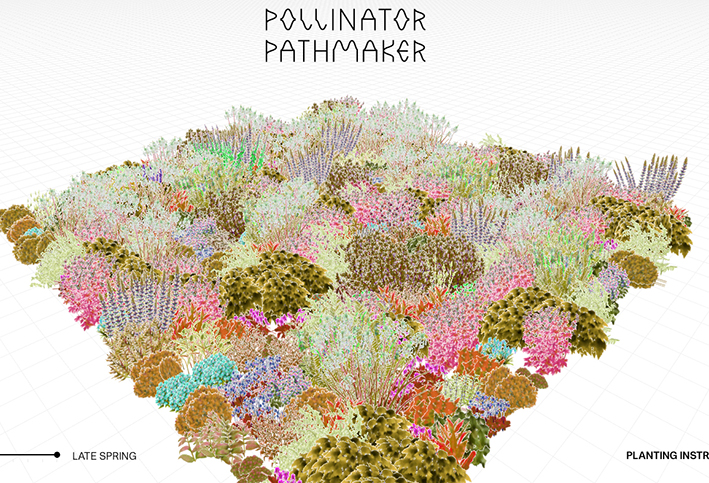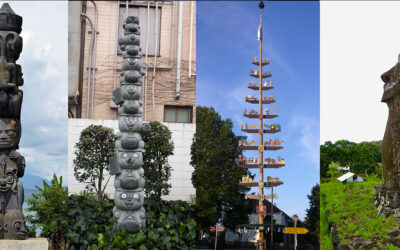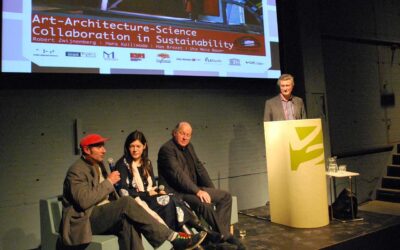Unveiling the Intersection of Art and Ecology in wild pollinator Conservation
Exploring art projects focused on bees yields a rich tapestry of creativity and concern. A simple search of “art” alongside “bees” unveils countless examples of art centred on honeybees. This abundance contrasts sharply with the relatively few artists delving into the nuances of wild bees—this, perhaps, owing to the intimidating diversity of wild bee species, diminished public interest, or the complex challenge of incorporating such themes into urban conservation efforts. Before delving into a brief review of this journey to find potential projects with varying degrees of impact, I’d like to spotlight a significant initiative that stands out as a true ecological intervention.
Daisy Ginsberg’s “Pollinator Pathmaker”: patchwork Blueprint for Change
British-South African artist Daisy Ginsberg’s expansive project bridges art and ecology, crafting pollinator-friendly spaces within urban landscapes. Although primarily an artistic installation, it’s deeply rooted in plant-pollinator research, aspiring to effect tangible change in urban ecological practices. The ‘Pollinator Pathmaker’ not only delights with digital interpretations of pollinator-preferred environments but also offers a practical manual for creating personalized gardens. Leveraging an algorithm, the project suggests a bespoke selection of European flowers tailored to specific locales, aimed at supporting a broad spectrum of pollinator species. Users input details like location, soil quality, shade/sun, incorporating personal preferences and in return, receive comprehensive planting instructions, including plant species selection, layout plans, and scheme advice to discourage weeds. This interactive platform vividly presents a virtual glimpse of the new floral arrangements as they would appear in different seasons, bringing the envisioned garden to life with remarkable clarity. https://pollinator.art
The Illusion of “Pollinating Cities” and “Bee Urban
In a research quest guided by AI, I encountered the ‘Pollinating Cities’ project, a venture that promised to intertwine art, science, and the greening of urban spaces for the betterment of the wild pollinator populations. Alexandra Dementieva, a name among the contributors, caught my attention, evoking a personal resonance and lending the project an air of familiarity and trust.
Yet, as the investigation unfolded, it became evident that both ‘Pollinating Cities’ and a similarly themed ‘Bee Urban’ project were fabrications—an intricate blend of imagination and digital prowess created by AI. The realization struck a cautionary note on the reliance upon AI for information vetting, especially when it spins tales that intertwine with real interests and connections. This uncovering of fictional projects, despite their compelling presentation and the inclusion of genuine names, highlighted the critical importance of scepticism and the need for thorough verification in the digital age.
Skepticism Surrounding BeeBricks and the Quest for Impactful Solutions
Taking a more design-oriented and entrepreneurial approach was the BeeBricks initiative based in Brighton, England. This concept found its way into local planning regulations, mandating inclusion in new constructions. However, Dave Goulson, a University of Sussex biology professor, expressed scepticism ‘We are kidding ourselves if we think having one of these in every house is going to make any real difference for biodiversity. Far more substantial action is needed, and these bricks could easily be used as ‘greenwash’ by developers’.
Beyond Art: Enacting True Environmental Change
The journey from conceptual art to impactful environmental intervention underscores the transformative potential of art. The most influential artistic initiatives are not content to challenge perceptions or stimulate discussions, but actively create change and create designs for future conservation efforts in a playful manner. This concrete transition from concept to execution is the true measure of success.
It takes patience to develop a process that effectively combines art and ecological activism into realisable interventions that create lasting change in practice and create replicable precedents, or blueprints, for future efforts.
Image: my personal choice of flower diversity with the Pollinator Pathmaker by Daisy Ginsberg


